Sedum (SEE-dum) commonly known as “Stonecrop” or “spreading Stonecrop”, is a flowering perennial succulent belonging to the Crassulaceae (krass-yoo-LAY-see-ee) family.
There are over 400 different Sedum plant varieties. One sedum variety many know is the Donkey Tail (Sedum morganianum).
Many Sedum plants have fleshy foliage and enjoy full sunThese easy-care, low-water plants are rock gardens favorites found in the Northern Hemisphere, but some members are native to South America and Africa.
Stonecrop Sedum Care
Size & Growth
Growth and spread of Sedum plants vary significantly from species to species. The low growing sedum may spread several feet but only grow a few inches high. This makes them excellent full sun candidates for rock gardens.
Upright varieties may grow as tall as 36″ inches tall and may need from 6″ inches to 2′ feet of surrounding area to grow and spread freely.
Check the specifics of the variety you choose to be sure to provide enough space and headroom.
Flowers, Bloom Time & Fragrance
Generally speaking, Sedum flowers are five-petaled and star-shaped.
The plant’s growing and bloom time stretches from early spring, early summer and into mid-autumn, depending upon the species.
Flower color ranges from white to intense purple. Flowers are generally lightly scented and are quite attractive to butterflies, bees and other pollinators.
Foliage
Like the flowers, the succulent leaves of Sedum vary greatly according to species. Shapes range from bean shaped to spatulate with a rosette growth pattern.
Foliage colors may range from light green to red to purple. Some plants have solid green foliage, and some are variegated. Some change colors with the seasons or in response to environmental stimuli.
Light & Temperature
Depending upon the variety, Sedum does best in full sun to partial shade. Many succulent sedum varieties are amazingly frost tolerant and will reappear every spring, even after long winters covered by snow.
Sedum tolerates a wide range of temperatures and is hardy in the United States from USDA hardiness zones 3 through 9.
Be sure to check the needs of the individual plant selected, before leaving it outdoors through a snowy winter.
When kept as a houseplant in the wintertime, keep temperatures high and consistent. When temperatures drop below 50° degrees Fahrenheit indoors, plants start to go dormant.
Keep indoor Sedums in a sunny window or under artificial lights at temperatures between 60° and 70° degrees Fahrenheit through the winter.
Watering & Feeding
Because these plants are drought tolerant succulents, they prefer deep, infrequent watering. Established plants may not require watering at all.
Be sure to check on the plants often to make certain they do not become too dry between waterings.
When you do water, use a soaker hose or other method of deep, ground watering. Avoid getting the leaves, stems, and flowers wet.
As long as you plant Sedum in a quality soil amended with a good supply of organic compost, fertilizing may not be required.
At the end of the growing season when Sedum dies back, mulch over the area with a rich, organic compost. The compost will feed the soil and protect the plants through the winter.
When you grow sedum plants in containers, fertilize using a weak solution designed for cactus or succulents.
As long the plants are divided annually and provided with fresh soil fertilizing is not necessary. Too much fertilizer is far worse on Sedums than no fertilizer at all.
Growing Sedum Soil & Transplanting
Sedum plants are commonly called Stonecrop because they don’t need rich soil to survive. Some sedums can grow between stones or in gravel.
Even so, if you’re keeping Sedum as a garden plant or houseplant, give it soil to help it to do its best.
In the garden, be sure the soil is light and well drained. Work in organic, compost matter, coarse sand and/or fine gravel as needed to provide a light, well-drained soil.
When kept as a houseplant, use a prepared cactus or succulent mix or make your own potting soil, combining coarse sand and/or coco coir.
Grooming & Maintenance
Once plants become established, they will not need much care. Prune as necessary to maintain or prevent unwanted spread.
Plants may be divided in the spring or in the autumn to help control their spread.
Deadheading does not promote blooms, so enjoy the flowers as they appear. Pinch off dead blossoms as you wish.
When plants finish flowering, cut them back to maintain the shape you desire. When they fade trim them back.
How To Propagate Sedum
You have many options when planting Sedum. These succulents can be grown from seed or cuttings or by division.
Seeds may be sown directly in average to rich, well-drained garden soil early in the spring. Keep the soil evenly moist.
The seed should germinate within a couple of weeks.
As the seedlings grow, thin out the weaker individuals. Thinning provides more growing space of 6″ inches to 2′ feet per plant for the stronger individuals.
When growing Sedum from divisions, divide the parent plant into two or more sections. Whether planting in a container or the garden, be sure the top of the root ball is level with the surface of the soil.
Propagating Sedum from cuttings couldn’t be easier. Start cuttings at any time throughout the growing season.
Just poke a hole in garden or container soil and insert the cut end of a bare stem. A good cutting for rooting is clear of leaves on the bottom couple of inches with 2-4 healthy succulent leaves on the top.
Keep the soil evenly moist, and the cutting should put out roots and begin to flourish within a matter of days.
Outdoors, creeping sedums will set down roots on its own. Look closely at the plant and locate sections that have started to grow roots.
Carefully cut these sections free and replant them in a container or a new location as you wish.
Sedum Pest or Disease Problems
If over watered or overcrowded, Sedum may be subject to infestation by scale insects and/or mealybugs. Slugs and snails may also be problematic outdoors.
As with all succulents, overwatering, overcrowding and lack of good air circulation can lead to root and stem rot.
To avoid these problems, be sure to give your plants plenty of space to grow and spread.
Use an appropriate pesticide to deal with mealybugs and scale insects indoors. Outdoors, encourage natural predators, such as ladybugs and lacewings.
Pickoff slugs and snails by hand. Thin plants to reduce hiding places and improve air circulation. Reduce watering to make the environment less welcoming to slugs and snails.
Crushed eggshells and/or diatomaceous earth sprinkled on the ground around affected plants may discourage these gastropods.
Is Sedum Considered Toxic or Poisonous To People, Kids, Pets?
For the most part, Sedum is edible and quite tasty.
One exception, Sedum rubrotinctum, (aka: Jelly-Beans or Pork and Beans) is a hybrid and not a true Sedum. Its leaves are poisonous, and its sap may cause skin irritation.
Is Easy To Grow Sedum Considered Invasive?
The plant spreads rapidly and could, conceivably, be considered invasive in just the right setting.
However, it is not officially considered invasive at this time.
Suggested Uses For Sedum Plants
For the most part, the best growing Sedum is happy when enjoying full sun, and loamy, sandy soil. This hardy, attractive plant does well in the garden, in containers or as a houseplant.
When outdoors, it draws butterflies and other pollinators.
The best use of these succulents depends upon the variety you choose.
With so many varieties available, select the ones suitable for your application. Low growing Sedum does very well as a ground cover and makes a great addition to xeriscaping and rock gardens.
Creeping varieties are also a good choice for filling in cracks between past pavers or rambling alongside footpaths.
These plants have small root systems, allowing you to plant them in these challenging locations by:
- Poking a hole in the soil
- Inserting a cutting
- Keeping the soil moist as the plant takes root
Rambling varieties, such as Donkey’s Tail, make great succulent hanging baskets. Tall sedum varieties do well as back borders in flower gardens. Some sedum types are good for use as cut flowers.
13 Top Choices For Sedum Plants
Sedum acre – Goldmoss Stonecrop
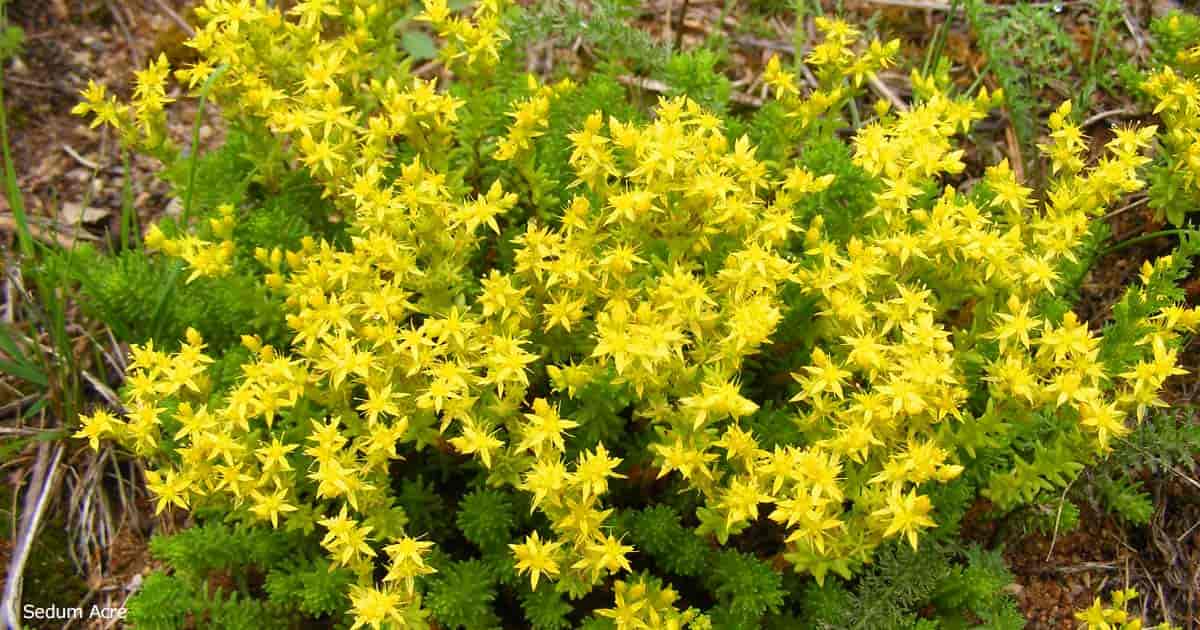 Goldmoss Sedum acre has bright yellow 5-petalled, almost star-shaped flowers.
Goldmoss Sedum acre has bright yellow 5-petalled, almost star-shaped flowers.
An evergreen, small, mat-forming plant, light green to yellow, thick, conical, leaves which have a peppery taste. Gold and variegated forms exist.
Sedum Album – White Stonecrop
The White Stonecrop aka Sedum album is a small, pretty, fragrant, star-shaped sedum with white flowers.
Album produces a thick plant with abundant clusters rising above the mat of foliage. It is attractive to butterflies and bees.
Sedum Spurium “Dragon’s Blood” Stonecrop
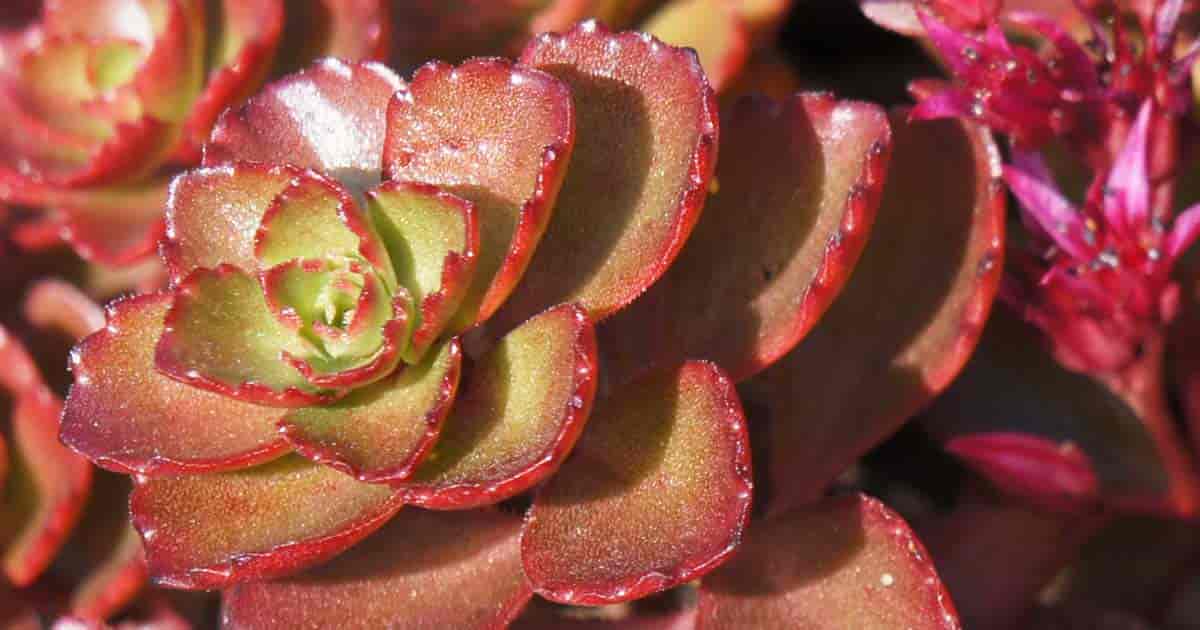 Sedum spurium (two-row stonecrop) blood stonecrop or Voodoo is a native of Eastern Europe.
Sedum spurium (two-row stonecrop) blood stonecrop or Voodoo is a native of Eastern Europe.
This trailing plant produces compact, colorful rosettes in shades ranging from deep, burgundy red to variegations in pink, white and green.
Sedum hispanicum – Spanish Stonecrop
The Spanish Sedum Stonecrop does very well planted between rocks and pavers.
Its leaves of medium green are small and needle-like, and the quickly spreading plant reaching a maximum height of only a couple of inches.
Sedum Kamtschaticum
Sedum kamtschaticum (Russian stonecrop) a dense perennial sedum used as a ground cover, container plant, or in a rock garden. Also used as a border or for mass plantings.
Sedum Dasyphyllum – Corsican Stonecrop
Sedum Dasyphyllum creates a carpet tiny round leaves of powdery bluish-green and sprout star-shaped flowers.
The plant color changes to a purple hue during winter.
Suitable for growing on green roofs, in dry walls’ crevices and between stepping stones.
Sedum reflexum – Blue Spruce
The Sedum reflexum (blue spruce sedum plants) is another good, low growing choice. This variety also has pretty yellow flowers, with blue-green foliage resembling that of the spruce tree.
Sedum adolphii – Golden Sedum
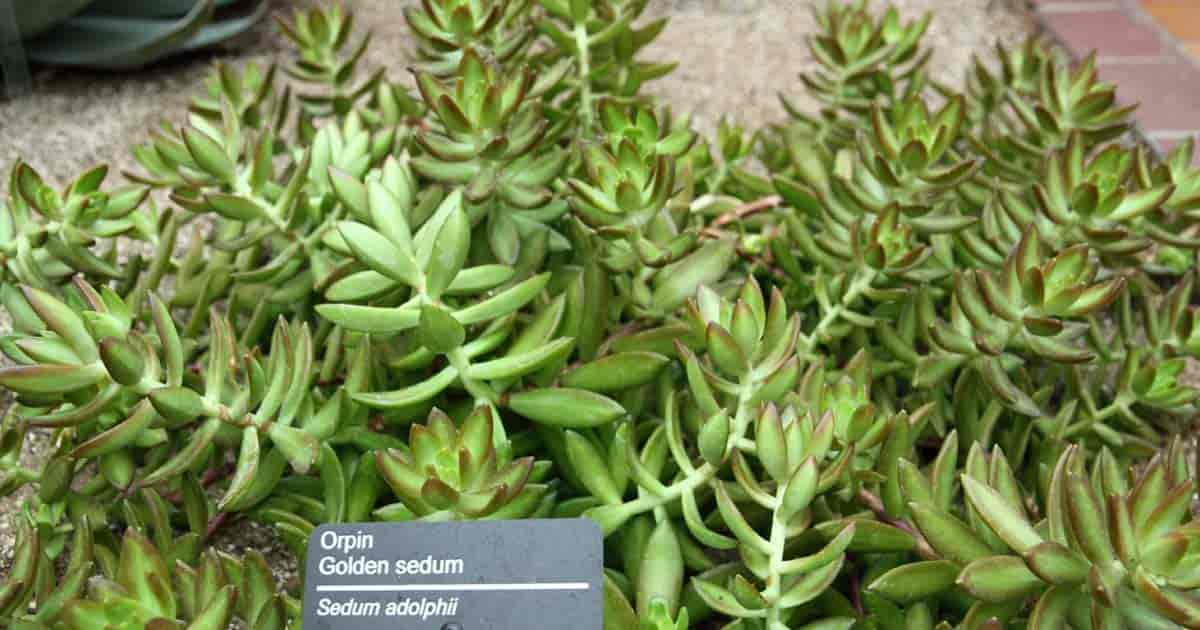 The Golden Sedum (Sedum adolphii) is a handsome, short, fleshy, sprawling plant with leaves of yellow-green tinged in red. A valuable addition to any collection.
The Golden Sedum (Sedum adolphii) is a handsome, short, fleshy, sprawling plant with leaves of yellow-green tinged in red. A valuable addition to any collection.
Sedum pachyclados – Gray Stonecrop
Pachyclados presents great bunches of tiny rosettes in a pretty shade of gray-green. Flowers are like tiny white stars.
A great plant for use as a ground cover in full sun to partial shade and needs very little water.
Sedum morganianum – Donkey’s Tail
The burro’s tail is a native of Mexico. This plant is an excellent choice for a hanging basket.
The “Burro’s tails” can grow to be as long as 4′ feet in a period of six to eight years.
This plant is sensitive to frost and does best in warmer climates and indoors.
Sedum sieboldii – October Daphne
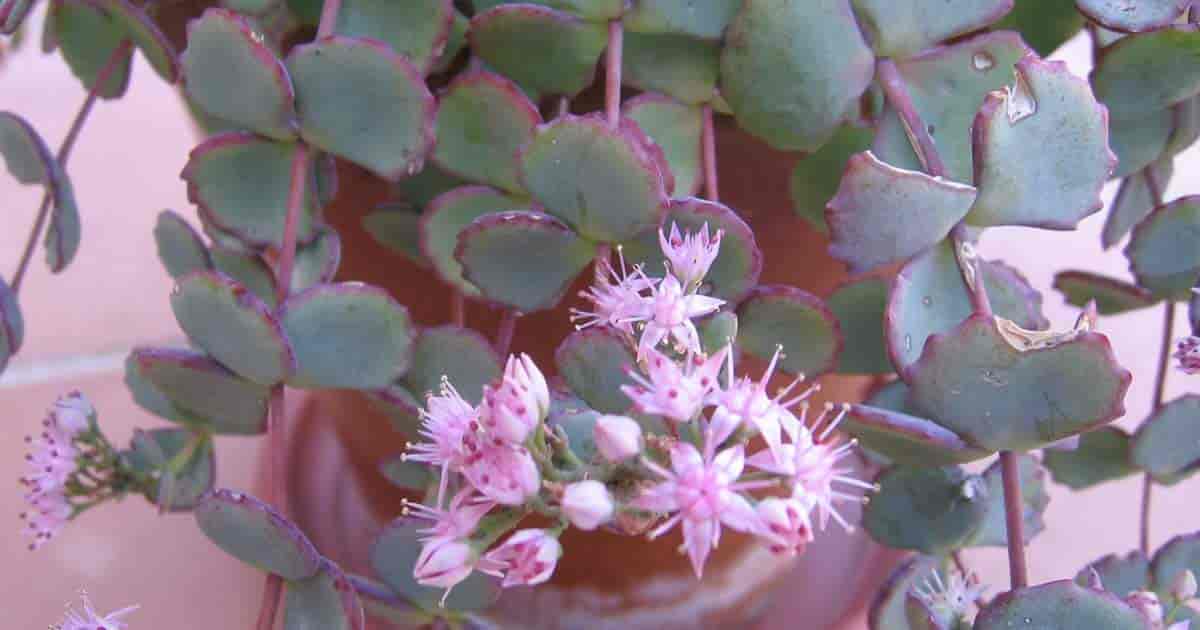 The sieboldii Sedum is an attractive small, sedum with a low, spreading growth habit.
The sieboldii Sedum is an attractive small, sedum with a low, spreading growth habit.
Sieboldii grows in circular mounds sending out horizontal branches from a center crown. The leaves are about 3/4″ inches around and blue-green growing in sets of three.
Deep pink leaf edgings, intensify as the season progresses. Fall leaf colors of pink, yellow, orange or bright red depending on light intensity.
Sedum spurium Tri Color – Spurium Tricolor
The tricolor stonecrop is a good choice as a ground cover. The plant has leaves of light green with white edging tinged with pink.
The pink blossoms are attractive to butterflies but resist deer and rabbits.
Sedum x rubrotinctum – Pork & Beans
Sedum rubrotinctum – Jelly Bean plant, Pork and Beans succulent is a sprawling plant with fat, red, bean-like succulent leaves providing lots of attractive color. It’s a good choice for a rock garden.
Plant in areas where pets and children will not tamper with it.
Sedum spathulifolium – Cape Blanco
Sedum spathulifolim (broadleaf stonecrop) is an excellent sedum for coastal gardens. It is a native of the coasts of California and does very well in poor soil.
It grows in compact rosettes of with leaves of a silvery blue-green.
Sedum rupestre – Angelina
Sedum Angelina displays pretty yellow flower heads sitting atop leaves of blue-green color. This plant is exceptionally tolerant of drought conditions and a good choice for covering large spaces when xeriscaping.
Sedum rupestre Lemon Ball – typically grows between 4” and 6” tall and has a spread of roughly 10” to 18” per plant.
Autumn Joy (Hylotelephium ‘Herbstfreude’ )
Sedum Autumn Joy is a beautiful, upright variety that does well as a back border or in containers.
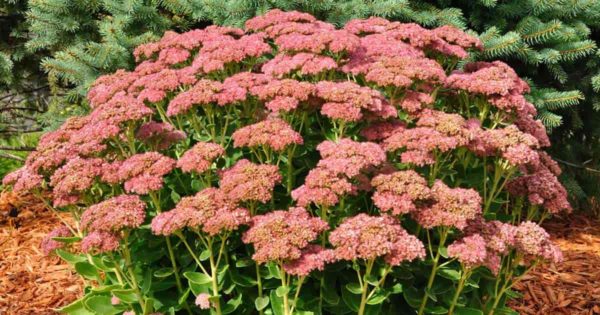 Popular Autumn Joy Sedum
Popular Autumn Joy Sedum
Autumn Joy grows to be approximately two feet high with pretty green leaves and showy pink blooms.
Sedum Autumn Fire
Sedum Autumn Fire has intense brick red color in the fall. Tighter growth habit and thicker foliage than ‘Autumn Joy’. Strong upright stems.
Sedum Purple Emperor
Purple emperor is an excellent choice if you want year-round interest in your garden.
The flowers are an attractive dusty pink, and the leaves a deep shade of burgundy. The plant grows about a foot high.
Sedum telephium – Matrona
Telephium (Sedum matrona) is an upright species with a height of about two feet and a spread of one to two feet.
Leaves range in color from medium green to deep burgundy. Purplish/pink flowers are a nice addition to a bouquet.
Sedum Divergens – Old Man’s Bones
Native to northern California. Creeping, low growing sedum succulent, excellent ground cover.
Sedum Divergens “Old Mans Bones” forms dense clumps or mats making a nice potted bowl or basket plant. In summer, plants are filled with bright yellow flowers.
Sedum Clavatum – Tiscalatengo Gorge Sedum
An attractive succulent perennial, Sedum clavatum grows as a ground cover in solid mats. The leaves of bluish-green are edged in pink or red in a rosette fashion.
Summary
Sedums come in all shapes and sizes, tiny, trailing, bushy and upright like the popular Autumn Joy. Size and shape vary highly among the species. But, all have fleshy leaves,
The flowers are starlike and usually small but with large clusters.
Smaller sedums provide texture, color and make lovely additions to rock gardens or planted as a decorative ground cover.




 Popular Autumn Joy Sedum
Popular Autumn Joy Sedum